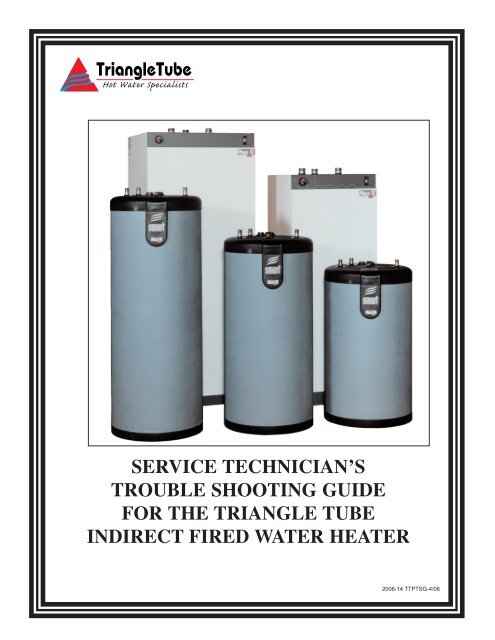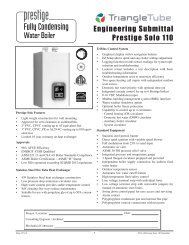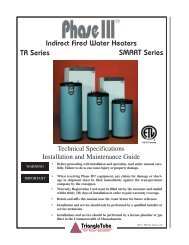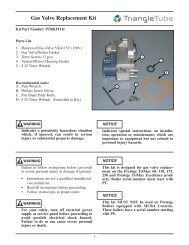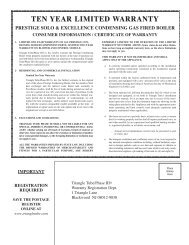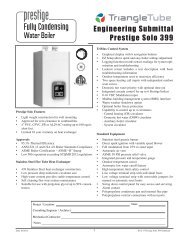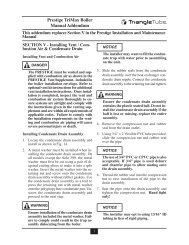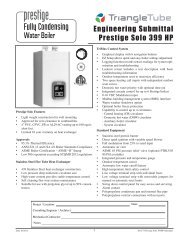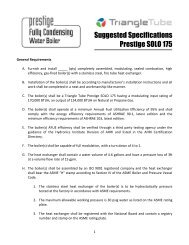Service Technician's Trouble Shooting Guide - Triangle Tube
Service Technician's Trouble Shooting Guide - Triangle Tube
Service Technician's Trouble Shooting Guide - Triangle Tube
You also want an ePaper? Increase the reach of your titles
YUMPU automatically turns print PDFs into web optimized ePapers that Google loves.
SERVICE TECHNICIAN’S<br />
TROUBLE SHOOTING GUIDE<br />
FOR THE TRIANGLE TUBE<br />
INDIRECT FIRED WATER HEATER<br />
2006-14 TTPTSG-4/06
WARNING<br />
Indicates a potentially hazardous situation, if ignored, can result in death, serious injury or substantial<br />
property damage.<br />
NOTICE<br />
Indicates special instructions on installation, operation or maintenance, which are important to the equipment/product,<br />
but not related to personal injury hazards.<br />
WARNING<br />
This guide is to be used in conjunction with the TR/Smart Installation and Maintenance manual.<br />
Procedures and servicing listed in this manual must be performed by a qualified service technician,<br />
installer, service agency or gas supplier. Any procedures or service performed by an unqualified<br />
individual or service agency can result in severe personal injury, death or substantial property<br />
damage.
Introduction<br />
<strong>Triangle</strong> <strong>Tube</strong> <strong>Service</strong> Technician’s <strong>Trouble</strong> <strong>Shooting</strong> <strong>Guide</strong><br />
This guide is to be used in conjunction with all <strong>Triangle</strong> <strong>Tube</strong> Indirect Fired Water Heaters (TR Series,<br />
SMART Series & HL Series) Technical Specifications Installation and Maintenance <strong>Guide</strong>.<br />
Good <strong>Trouble</strong> <strong>Shooting</strong> Practices<br />
Before leaving for the job site:<br />
• Check your parts and tools.<br />
- Test equipment and tools that you will need:<br />
Electrical meter that can measure voltage and continuity.<br />
Pressure gauge, Watts #276H300 Test Gauge.<br />
Temperature gauge<br />
Bucket, 1 gallon or larger with volume markings.<br />
Stopwatch<br />
- Parts to solve most problems:<br />
Thermostat (Aquastat) Kit P3KITTH01<br />
O-Ring Kit P3KITT0R01<br />
• Know the water heater model number.<br />
• Know boiler manufacturer and model number.<br />
• Review all appropriate manuals before leaving for the job site.<br />
At the job site:<br />
• Clarify the problem.<br />
• Have this manual and any boiler manuals and/or wiring and piping schematic readily available<br />
• Turn to page 2 -- read carefully and follow instructions step by step.<br />
Remember !!<br />
Follow the <strong>Trouble</strong>shooting <strong>Guide</strong> step by step, always double checking your results. Skipping steps or not<br />
completing steps can lead to wrong conclusions, repeated visits to the job site, unhappy customers and unnecessary<br />
warranty claims.<br />
1
Index<br />
Situation<br />
Insufficient<br />
Hot Water<br />
No<br />
Excessive Domestic<br />
Water Temperature<br />
No<br />
Boiler Relief Valve<br />
Lifting or Weeping<br />
No<br />
Temperature/Pressure<br />
Relief Valve Lifting<br />
or Weeping<br />
Water Found on the<br />
Floor Near the Tank<br />
No<br />
Yes<br />
Yes<br />
Yes<br />
Yes<br />
Yes<br />
Corrective Action Section<br />
Insufficient Hot Water - page 3<br />
- Undersized water heater<br />
- Boiler system improperly sized<br />
- Check component parts<br />
- Boiler operating temperature<br />
- Location of flow control devices<br />
- Air in system<br />
- Clean boiler system<br />
Excessive Water Temperature - page 6<br />
- Reduce Staking<br />
- Lowering boiler operating temperature<br />
- Relocating T-stat bulb<br />
- Reverse boiler piping<br />
- Install thermostatic mixing valve<br />
- Recirculation loop<br />
Boiler Relief Valve Lifting or Weeping - page 7<br />
- Undersized boiler expansion tank<br />
- Faulty boiler expansion tank<br />
- Simulate maximum expansion<br />
- Faulty boiler relief valve<br />
- Faulty boiler fill valve<br />
- Inner tank leak<br />
T&P Relief Valve Lifting or Weeping - page 8<br />
- Undersized or missing domestic<br />
side expansion tank<br />
- Faulty domestic expansion tank<br />
- Faulty T&P relief valve<br />
- High domestic supply pressure<br />
- Possible water hammering or pressure spikes<br />
- Boiler operating temperature<br />
Water on the Floor - page 9<br />
- From sources other than the water heater<br />
- T&P valve lifting and discharging<br />
- Loose piping connections<br />
Top of Tank/<br />
Insulation Wet<br />
No<br />
Water Quality<br />
Problems<br />
Yes<br />
Yes<br />
Top of Tank / Insulation Wet - page 10<br />
- From sources other than the water heater<br />
- Loose piping connections<br />
- Leakage from the drywell<br />
Water Smells / Taste Bad - page 11<br />
- Water smells like "rotten eggs"<br />
- Milky water<br />
- Rusty discolored water<br />
2
Insufficient Hot Water<br />
Is the water heater undersized for the application<br />
- There are many methods of sizing various applications, i.e. ASHRAE sizing tables, or ASPE domestic<br />
water heating design manual, re-confirm the water demand required for the application.<br />
- Re-confirm the flow rates of the fixtures. Was the tank sized for shower heads at 2.0 gpm, when the<br />
actual heads are 5.0 gpm? Use a bucket and a stopwatch to determine fixture flow rates.<br />
- Evaluate the hot water usage pattern for a day. Is the peak demand unusually high for the application?<br />
Domestic Demand gph =<br />
- Has the demand for domestic hot water changed since the system was installed? A bathroom remodeling<br />
project with a newly installed whirlpool tub will drastically change the domestic water demand.<br />
Is the boiler system properly sized<br />
- Is the boiler providing the required output of BTU’s to meet the domestic water load?<br />
Domestic Demand gph =<br />
Blr Output BTU's<br />
(Temp. Rise ¼F x 8.33)<br />
Blr Output BTU's<br />
(Temp. Rise ¼F x 8.33)<br />
Temp Rise ºF = Desired Temp.ºF - Incoming Temp.ºF<br />
8.33 = Density of Water lbs/gal. x 1 Btu/lbs ºF<br />
Example: A single family home with a 3.0 gpm shower fixture and a 150,000 Btu/hr output boiler<br />
capacity. Is the boiler capacity adequate to deliver 115ºF water for an extended period?<br />
Domestic Demand gph =<br />
The boiler capacity is capable of delivering 4.6 gpm continuously which is adequate for this application.<br />
Action Item:<br />
Domestic Demand gph =<br />
150,000 Btu/hr<br />
[(115¼F - 50¼F) x 8.33]<br />
150,000 Btu/hr<br />
= 277 gph<br />
= 277 gph<br />
- Measure the BTU input to the boiler by clocking the gas meter or finding the oil flow rate<br />
based on nozzle size and pump [(115¼F pressure. - 50¼F) x 8.33]<br />
- Does the hot water system need to be wired for domestic priority? For systems in which either the<br />
storage or BTU’s available are marginal it is recommended to wire the domestic water heater in a priority<br />
manner.<br />
- Is the boiler piping to the water heater properly sized to allow the required flow rate for maximum<br />
BTU transfer? The temperature differential of the boiler supply and return water should be 20ºF to<br />
30ºF.<br />
3
Insufficient Hot Water<br />
- Is the circulator between the boiler and the water heater properly sized to provide adequate flow for<br />
maximum BTU transfer?<br />
Check component parts<br />
- Is the domestic water thermostat functioning properly? With a electrical voltmeter check for continuity<br />
between terminals C and 1 on the snap-set connection.<br />
Action Item:<br />
1. Disconnect the snap-set connector on the <strong>Triangle</strong> <strong>Tube</strong> water heater.<br />
2. Turn the thermostat knob to the highest setting - clockwise to initiate a call for heat.<br />
3. Check for continuity between terminals C and 1 (end connectors on the snap-set). On a call<br />
for heat, these contacts should be in the close position.<br />
4. Continue checking for continuity while turning the thermostat knob to the lowest setting -<br />
counter clockwise to satisfy the call for heat. The contacts should open, breaking the continuity.<br />
5. If any of these steps fail, replace the thermostat.<br />
6. Reconnect the snap-set.<br />
- Is the thermostat setting too low? If the thermostat setting is too low the boiler may not have the<br />
opportunity to deliver the maximum BTU’s required to completely heat the entire volume of water<br />
stored in the tank.<br />
- During a call for heat by the water heater, does the boiler circulator begin pumping, does the zone<br />
valve open, does the boiler fire? Check every component in the system to ensure they are properly<br />
functioning.<br />
- Check the thermostat sensing bulb size and fit into the drywell. Some older units have a sensing bulb<br />
that is thinner and fits loose inside the drywell. The newer thermostats have a larger bulb which fits<br />
tighter in the drywell allowing better heat transfer for more accurate water temperature sensing.<br />
Action Item:<br />
Pipe Size Flow Rate BTU's Transfer<br />
3/4" 3 to 7 gpm 50 to 100 MBH<br />
1" 8 to 15 gpm 100 to 180 MBH<br />
1 1/4" 12 to 25 gpm 160 to 300 MBH<br />
1 1/2" 18 to 35 gpm 200 to 450 MBH<br />
2" 30 to 55 gpm 300 to 650 MBH<br />
- If the sensing bulb does not slide into the drywell; remove burrs from top 1 1/2” inside the drywell<br />
with a 3/8” drill.<br />
4
Insufficient Hot Water<br />
- What is the location of the thermostat bulb? A bulb inserted completely at the bottom of the drywell<br />
will initiate a quicker response for a call for heat. This is typically the position of the bulb required<br />
for applications in which there are large draws of domestic water.<br />
- Remove and examine the dip tube located in the cold water inlet. Replace if damaged. A broken or<br />
melted dip tube will cause the cold water to discharge across the top of the tank, thus short cycling the<br />
water heater.<br />
Check the operating temperature of the boiler<br />
- If possible increase the boiler operating temperature to 180ºF or 200ºF.<br />
- Maintain a minimal temperature in the boiler during non-heating seasons. A boiler typically has a<br />
higher standby loss than the indirect water heater. After a long standby period the colder boiler may<br />
absorb the stored energy within the water heater during the initial call for heat.<br />
Check location of flow control devices<br />
- Lab tests have shown that during long standby periods the boiler piping can act as a thermal siphon<br />
and draw stored heat from the domestic water. Locate flow control devices (zone valve, spring check<br />
valves...) or heat trap loops in the boiler piping close to the water heater. Insulate all boiler piping to<br />
and from the water heater.<br />
Check for air in the system<br />
- An air bound water heater or boiler will not circulate system water properly, resulting in a lack of heat<br />
transfer.<br />
Clean the boiler system<br />
- A dirty boiler system can cause deposits to form on the outer wall of the inner tank, which insulates<br />
the tank, affecting the heat transfer. Clean the boiler system per the boiler’s manufacturer’s instructions.<br />
Action Item:<br />
- Install a strainer in the boiler piping on older installations or for systems prone to becoming<br />
dirty.<br />
5
Excessive Water Temperature<br />
Excessive water temperature is usually the result of stacking within the water heater. Stacking is the occurrence<br />
of various water temperatures layering within the water heater with the hottest water in the uppermost<br />
layer. This layering or stacking effect typically occurs during small draws of hot water (typically less than<br />
25% of the storage capacity) which are long enough to create a call for heat on the thermostat, but are short<br />
enough not to deplete the stored energy within the tank. Excessive stacking can occur when frequent short to<br />
moderate draws are taken in quick succession. During this type of situation, the temperature of the domestic<br />
water can approach the temperature of the boiler water.<br />
REMEMBER:<br />
All water heaters (direct and indirect) will stack.<br />
Reducing stacking within the tank<br />
- Reduce the boiler operating temperature to 160ºF - 170ºF. This will limit the maximum domestic outlet<br />
water temperature during high stacking water usage.<br />
- Raise the thermostat sensing bulb higher in the drywell. This will reduce the frequency of thermostat<br />
calls for heat during small draws of hot water. However, it will reduce the quantity of available hot<br />
water during a deep draw by delaying the call for heat to the boiler.<br />
- Reverse the boiler side piping. The older installations may have the boiler supply at the top of the<br />
water heater and return at the bottom. Reversing the piping, supply at the bottom and return at the top<br />
will:<br />
a) Result in lower tank stacking by having the hottest boiler water closer to the cooler incoming<br />
domestic water.<br />
b) Reduce the effect of “thermal overshoot” after the thermostat call for heat has been satisfied.<br />
c) Provide a more uniform hot water delivery temperature during moderate to deep draws (25% to<br />
100% of the tank’s storage capacity).<br />
Reversing the boiler piping will not affect the performance of the water heater.<br />
Install thermostatic mixing valve<br />
- Installation of a thermostatic mixing valve will provide an uniform delivery temperature with minimal<br />
regard to water usage.<br />
Recirculation Loop<br />
- Installation of a properly sized recirculation loop not only provides prompt delivery of hot water, but<br />
it provides circulation and mixing of the water within the tank.<br />
6
Boiler Relief Valve Lifting or Weeping<br />
Is the expansion tank on the boiler side properly sized?<br />
- The additional quantity of boiler water contained in the outer tank must be considered when sizing the<br />
boiler side expansion tank.<br />
- Insufficient allowance for expansion on the boiler side can cause the boiler pressure relief valve to lift.<br />
Is the expansion tank defective, water logged or improperly charged?<br />
- Check for failed gaskets or bladders, or a faulty Schraeder valve.<br />
- Use a tire gauge to check the charged pressure of the tank<br />
Action Item:<br />
- Increase the boiler operating temperature and let the system run at the higher temperature.<br />
This will simulate maximum expansion in the boiler system.<br />
- If the boiler relief valve lifts and/or there is a significant increase in the boiler system pressure,<br />
the expansion tank is flooded or undersized.<br />
Is the boiler pressure relief valve functioning properly?<br />
- Dirt and water deposits can accumulate under the valve seat.<br />
Check the boiler automatic fill valve for defects.<br />
- Is the valve filling to the correct pressure?<br />
Check for possible inner tank leak<br />
Model<br />
Boiler Side<br />
Capacity gal.<br />
TR-20 8<br />
TR-30 9<br />
TR-36 12<br />
TR-45 8<br />
TR-60 8<br />
TR-75 15<br />
TR-120 30<br />
SMART 20 / HL-20 5<br />
SMART 30 / HL-30 5<br />
SMART 40 / HL-36 6<br />
SMART 50 / HL-45 8<br />
SMART 60 / HL-60 8<br />
SMART 80 14<br />
SMART 100 25<br />
SMART 120 43<br />
- If possible, isolate the <strong>Triangle</strong> <strong>Tube</strong> tank from the boiler system for an extended period of time.<br />
Observe the boiler system pressure during that time.<br />
7
Is there a thermal expansion tank installed on the domestic supply piping and is it properly sized?<br />
- A thermal expansion tank is required if the domestic supply piping includes a backflow preventer or<br />
pressure reducing valve.<br />
- Ensure the potable water expansion tank is properly sized according to the water heater volume and<br />
supply pressure.<br />
- During long periods when there is no draws from the tank (i.e. overnight), the T&P relief valve may<br />
lift or weep due to thermal expansion, but may function properly during normal periods of tank draws.<br />
Is the expansion tank defective, water logged or improperly charged?<br />
- Check for failed gaskets or bladders, or a faulty Schraeder valve.<br />
- Use a tire gauge to check the charged pressure of the tank<br />
Is the temperature/pressure relief valve functioning properly?<br />
- Dirt and water deposits can accumulate under the valve seat.<br />
Check the domestic supply pressure entering the water heater.<br />
- If the pressure is over 70 psi it is recommended to install a pressure reducing valve. This will prevent<br />
any pressure spikes or increases in pressure due to thermal expansion which may cause the T&P valve<br />
to lift or weep.<br />
Check the domestic system for possible sources of water hammering or pressure spikes.<br />
- Some appliances such as clothes washers and dishwashers utilize fast acting valves which may cause<br />
water hammering or pressure spikes through the domestic water system.<br />
Action Item:<br />
Temperature/Pressure Relief Valve Lifting or Weeping<br />
- Install water hammer arrestors as required per the manufacturer’s instructions, or install flexible<br />
connectors to isolate the tank from the domestic system.<br />
Check the operating temperature of the boiler<br />
- If the boiler operating temperature is excessive, 200ºF or higher, stacking can occur in the inner tank<br />
raising the domestic water temperature close to the boiler operating temperature.<br />
Action Item:<br />
- Reduce the boiler operating temperature to 180ºF.<br />
8
Water on the Floor<br />
Is the source of the water from the tank?<br />
- Check for possible water seepage through foundation cracks. Did the water appear after a heavy rain?<br />
Is the source of water from the T&P relief valve?<br />
- Place a bucket under the discharge piping of the T&P relief valve and monitor it for a day or two. This<br />
is a procedure that can be done by the homeowner.<br />
- If the T&P relief valve is the source, refer to the T&P Relief Valve section of this guide.<br />
Check all connections - boiler connections, domestic connections....<br />
- Check all the boiler connections to the water heater. A build-up of corrosion is a sure sign of a leak.<br />
- Check the domestic connections. Look at the welds where the spuds enter into the outer tank.<br />
Excessive water hammering in the domestic system may crack these welds.<br />
- Check the seal around the air vent and drywell for leaks. Remove the drywell and check the O-ring<br />
gasket (if applicable) beneath it.<br />
Action Item:<br />
- To replace the drywell O-ring (if applicable) use the O-Ring Replacement Kit (P/N<br />
P3KITOR01). When re-installing the drywell with a rubber O-Ring gasket do not over tighten<br />
and crush or tear the O-ring.<br />
- Apply sealant (i.e. Leaklok or Loctite) completely around threads in all applications.<br />
9
Is the source of the water from the tank?<br />
- Check for possible overhead pipes leaking onto the tank<br />
Top of Tank / Insulation Wet<br />
Check all connections - domestic connections, air vent....<br />
- Check the connections to the water heater. Are they loose? A build-up of corrosion around joints is<br />
a sure sign of a leak.<br />
- Check the domestic connections. Look at the welds where the spuds enter into the outer tank.<br />
Excessive water hammering in the domestic system may crack these welds.<br />
- Check the seal around the air vent and drywell for leaks. Remove the drywell and check the O-ring<br />
gasket (if applicable) beneath it.<br />
- Remove the thermostat sensing bulb from the drywell. Is the bulb wet or is water visible at the top of<br />
the drywell? If so, replace the entire drywell.<br />
Action Item:<br />
- To replace the drywell O-ring (if applicable) use the O-Ring Replacement Kit (P/N<br />
P3KITOR01). When re-installing the drywell with a rubber O-Ring gasket do not over tighten<br />
and crush or tear the O-ring.<br />
- Apply sealant (i.e. Leaklok or Loctite) completely around threads in all applications.<br />
10
Water Smells /Tastes Bad<br />
The hot water smells like “rotten eggs”<br />
The most common cause of water to smell like “rotten eggs” is a non-toxic sulfate reducing bacteria. The<br />
bacteria usually enters into the water system through a break in the supply piping or during construction/maintenance<br />
of the supply piping. The bacteria survives in the water system by converting sulfate (SO4) in the<br />
water to hydrogen sulfide (H2S) gas. It is this gas that creates the “rotten egg” smell. The presence of hydrogen<br />
sulfide can also affect the taste of the water as well. Along with the stench caused by this bacteria, black<br />
deposit which typically indicate pipe and/or fitting corrosion may also appear in the water.<br />
WARNING<br />
In extremely high concentrations, hydrogen sulfide gas can be toxic. However, the gas is detectable<br />
prior to reaching harmful levels.<br />
The bacteria will thrive in any water system under the following conditions:<br />
• High levels of sulfur in the water<br />
• Activated hydrogen in the water from cathodic reactions within the tank<br />
• Water with little or no dissolved oxygen<br />
• Storing the domestic water below 140ºF<br />
Other causes of smelly water:<br />
• Chlorides of magnesium and calcium gives water a bitter taste<br />
• Chloride of sodium will produce a salty tasting water<br />
• Sulfates above 50 ppm in the water gives the water a medicinal taste.<br />
• Carbon dioxide in water with a low pH results in water that is fizzy.<br />
• Iron and tannic waters will produce water with a bad taste and odor.<br />
Action Item:<br />
- The treatment of this situation requires the water system to be shock-chlorinated. Depending<br />
on the severity of the bacteria within the water system, several treatments may be needed.<br />
11
Hot water from the faucet appears milky<br />
Water Smells / Tastes Bad<br />
When water is initially drawn from the faucet it appears to be milky or cloudy, but it becomes clear after the<br />
water is allow to stand for several minutes. This is usually an indication that the water contains high levels<br />
of soluble gases such as oxygen, chlorine, carbon dioxide, hydrogen sulfide or others.<br />
As the water system pressure increases, the amount of gas that water can hold in a solution decreases. When<br />
air and gases are forced out of the heated water, the problem may be evident in one or both of the following<br />
conditions:<br />
• Gases, in the form of small bubbles, may make the water appear milky from the tap, but clear after<br />
several minutes when those bubbles will separate. Similar to the reaction that occurs as air bubbles<br />
form on the walls of a pan shortly before the water begins to boil.<br />
• The release of dissolved gas can also create air pockets and air locks in the water system piping. This<br />
can cause spurts of air or gases when opening the hot water faucet.<br />
There is generally no cure for milky water cause by dissolve gases, although it can be reduced with aerated<br />
faucets. In some applications the amount of air and gases precipitating out of the water will reduced in time.<br />
It should be noted that these gases are not harmful to the end user.<br />
12
Water Smells / Tastes Bad<br />
Discolored water from the hot water faucet<br />
The water from the hot water faucet appears discolored, either rusty, brown, black or yellow. Because the<br />
inner tank is stainless steel, which by its nature is resistant to corrosion, the problem is not tank related. The<br />
problem is usually a non-toxic iron reducing bacteria that is commonly found in soil, well water, water treatment<br />
plants and piping systems. The bacteria usually thrives in those systems in which the soluble iron<br />
exceeds 0.2 ppm. The bacteria will feed on the soluble iron in the water producing “rusty” color water as a<br />
by-product of the feeding process.<br />
Variables in which the bacteria can thrive in:<br />
• Elevated levels of iron and manganese in the water<br />
• Water with little or no dissolved oxygen<br />
• Water storage temperatures below 140ºF<br />
Items that can potentially increase the presence of the bacteria:<br />
• Water softeners<br />
• Well water<br />
• Long periods of no water movement<br />
Action Item:<br />
- The treatment of this situation requires the water system to be shock-chlorinated. Depending<br />
on the severity of the bacteria within the water system, several treatments may be needed.<br />
13
Products Description<br />
TR SERIES<br />
TR-20/30/36/80/100/120<br />
Domestic Hot<br />
Water Outlet<br />
C<br />
Auxiliary<br />
Connection<br />
2"<br />
Boiler Water Return<br />
(TR-20 thru TR-36)<br />
Boiler Water Supply<br />
(TR-45 thru TR-120)<br />
D<br />
E<br />
Drywell for Remote<br />
Sensing Bulb<br />
1/2" NPT<br />
Air Vent<br />
Domestic Hot<br />
Water Outlet<br />
D<br />
1/2" NPT<br />
Air Vent<br />
TR-45/60<br />
C<br />
Domestic Cold<br />
Water Inlet<br />
4 1/8"<br />
Domestic Cold<br />
Water Inlet<br />
Auxiliary<br />
Connection<br />
4 1/8"<br />
E<br />
Drywell for Remote<br />
Sensing Bulb<br />
Side view<br />
F A<br />
B<br />
Boiler Water Supply<br />
(TR-20 thru TR-36)<br />
Boiler Water Return<br />
(TR-45 thru TR-120)<br />
Top views<br />
14
Products Specifications<br />
SMART SERIES (1)<br />
Specifications<br />
Air Vent<br />
Cold Water<br />
Inlet<br />
Auxiliary<br />
Connection<br />
Hot Water<br />
Outlet<br />
Cold<br />
Water Inlet<br />
Hot<br />
Water Outlet<br />
Boiler<br />
Return<br />
C<br />
A<br />
22"<br />
Boiler<br />
Supply<br />
Thermostat<br />
Cover Plate<br />
14 1/4"<br />
Auxiliary<br />
Connection<br />
Top view SMART-20/30/40/50/60<br />
Air Vent<br />
Thermostat<br />
& Drywell<br />
Hot Water<br />
Outlet<br />
22"<br />
B<br />
Rear view SMART-20/30/40/50/60<br />
Cold Water<br />
Inlet<br />
Boiler<br />
Return<br />
Auxiliary<br />
Hot Water<br />
Outlet<br />
C<br />
A<br />
Cold Water<br />
Inlet<br />
10 5/8"<br />
Auxiliary<br />
Connection<br />
Top view SMART 80/100<br />
Boiler<br />
Supply<br />
26"<br />
B<br />
Rear view SMART 80/100<br />
15
Products Specifications<br />
Specifications<br />
Cold<br />
Water Inlet<br />
Thermostat<br />
Cover Plate<br />
SMART SERIES (2)<br />
Air Vent<br />
Hot<br />
Water Outlet<br />
Boiler<br />
Return<br />
Cold Water<br />
Inlet<br />
Auxiliary<br />
Connection<br />
Hot Water<br />
Outlet<br />
22"<br />
C<br />
A<br />
Boiler<br />
Supply<br />
14 1/4"<br />
Auxiliary<br />
Connection<br />
Top view SMART-20/30/40/50/60<br />
Air Vent<br />
Thermostat<br />
& Drywell<br />
Hot Water<br />
Outlet<br />
22"<br />
B<br />
Rear view SMART-20/30/40/50/60<br />
Cold Water<br />
Inlet<br />
Boiler<br />
Return<br />
Auxiliary<br />
Hot Water<br />
Outlet<br />
C<br />
A<br />
Cold Water<br />
Inlet<br />
10 5/8"<br />
Auxiliary<br />
Connection<br />
Top view SMART 80/100<br />
Boiler<br />
Supply<br />
26"<br />
B<br />
Rear view SMART 80/100<br />
16
Products Specifications<br />
HL SERIES<br />
Specifications<br />
2"<br />
Drywell for remote<br />
Sensing Bulb<br />
Auxiliary<br />
Connection<br />
16"<br />
Domestic Cold<br />
Water Inlet<br />
Boiler Water<br />
Return<br />
45º<br />
B<br />
22"<br />
A<br />
12"<br />
Boiler Water<br />
Supply<br />
Domestic Hot<br />
Water Outlet<br />
7" 7"<br />
1/2" NPT<br />
Manual air vent<br />
C<br />
2"<br />
Top view HL-20/30/36/45/60<br />
20"<br />
Side view HL-20/30/36/45/60<br />
Boiler Water<br />
Return<br />
Auxiliary<br />
Connection<br />
Domestic Cold<br />
Water Inlet<br />
B<br />
A<br />
Domestic Hot<br />
Boiler Water<br />
Water Outlet<br />
Supply 5" 5"<br />
1/2" NPT<br />
Manual air vent<br />
C<br />
Drywell for remote<br />
Sensing Bulb<br />
Top view HL-80<br />
28"<br />
Side view HL-80<br />
17
<strong>Triangle</strong> <strong>Tube</strong>/Phase III Co., Inc.<br />
Freeway Center - 1 <strong>Triangle</strong> Lane - Blackwood, NJ 08012<br />
Tel: (856) 228 8881 - Fax: (856) 228 3584<br />
E-mail: Info@triangletube.com - http://www.triangletube.com<br />
Member of<br />
Group


